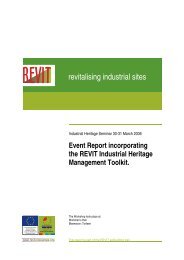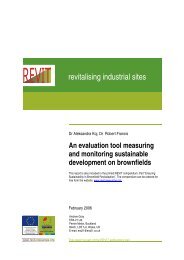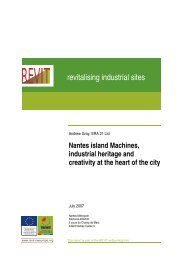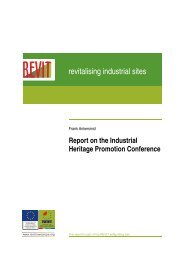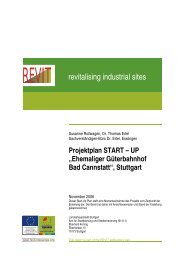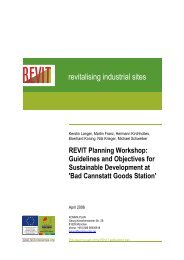REVIT Heritage Report.pdf
REVIT Heritage Report.pdf
REVIT Heritage Report.pdf
You also want an ePaper? Increase the reach of your titles
YUMPU automatically turns print PDFs into web optimized ePapers that Google loves.
Torfaen County Borough Council<br />
<strong>REVIT</strong>: A Review of the Conservation of Industrial <strong>Heritage</strong> Assets on Brownfield Sites<br />
strategic overview to be involved in co-ordinating the phases of urban<br />
regeneration that involve heritage.<br />
5.4.4 The impact of individual projects can only be sustained if local authorities<br />
operate the system of statutory heritage protection effectively and fairly,<br />
including statutory consent, enforcement, repairs notices, compulsory<br />
purchase orders and directions.<br />
5.4.5 There is a delicate relationship between any regeneration funding and the<br />
operation of the local property market. Initial investment may change<br />
perceptions of an area which can then create a speculative property market<br />
where properties are bought up and left empty in the hope of a rising market.<br />
5.4.6 Archaeological sites, historic buildings and green spaces are often the key to<br />
regeneration schemes: individually they can be centrepieces, landmarks, or<br />
symbols of an area; collectively they can set a framework, a context, or an<br />
architectural standard. However, whilst many heritage schemes have focused<br />
very much on physical repairs to property it is important that there should be a<br />
sustainable use for the property and that there should be strong community<br />
involvement in the scheme.<br />
5.4.7 High quality historic buildings actually set the architectural standards for<br />
adjacent new developments. The very presence of historic buildings demands<br />
sensitive and high quality architecture. Some of the most exciting and<br />
stimulating urban areas derive their character from an inventive juxtaposition of<br />
old and new.<br />
5.4.8 The quality of conservation work will be an important element in the success of<br />
any regeneration project. Well-conserved historic buildings, archaeological<br />
sites and spaces can add value to a place; poor conservation can erode the<br />
character and quality of an area just as easily as poor new design.<br />
5.4.9 A recent English <strong>Heritage</strong> survey reported (English <strong>Heritage</strong>, 2003) that:<br />
• a MORI poll for <strong>Heritage</strong> Counts 2003 revealed that 92% of people thought<br />
it important to keep historic features when regenerating towns and cities<br />
and 90% said heritage meant their local area as well as castles and stately<br />
homes. 82% thought heritage could be fun;<br />
• houses built before 1919 are worth, on average, some 20% more than an<br />
equivalent house from a more recent era;<br />
• a Victorian terraced house is cheaper to maintain over a 100-year period<br />
than a 1980’s house;<br />
• the total energy already used in the construction of a typical Victorian<br />
terrace would power a car to go five times round the earth, or halfway to<br />
the moon;<br />
• a total of 130,000 new houses are built every year but only 20,000 new<br />
homes each year result from conversions of existing stock;<br />
• not all empty houses can be made habitable again. But there are 40,000<br />
privately owned long-term vacant properties in London and 30,000 in the<br />
South East – areas where there is a shortage of homes for key workers.<br />
5.4.10 Their inhabitants often hold historic areas in great affection; they are very<br />
much part of "the cherished local scene" and their maintenance and<br />
improvement is the subject of great local pride. They contribute to social<br />
engagement, even health and well-being. The repair of historic buildings,<br />
0014021/JM/001 43




